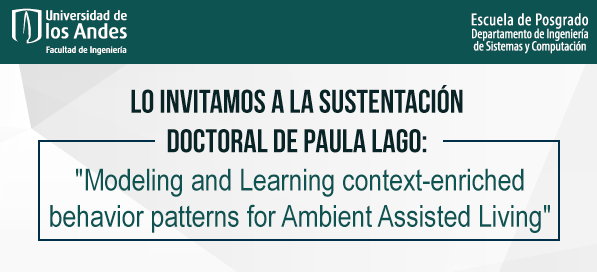"Modeling and Learning context-enriched behavior patterns for Ambient Assisted Living"
World Population is ageing at a rapid pace, bringing challenges to societies. Information and Communication Technologies may play a key role in improving the quality of life of elders. In particular, smart home services allow independent and in-place aging by monitoring their activities of daily living and alerting when a risk situation is detected. For example, when the person has forgotten to eat or when she goes out after certain hours. However, current solutions only consider general unsafe situations or require users to declare what an unsafe situation is. In this way, personal lifestyles or routines are not considered. This may lead to many false positive alarms and reduce user acceptance.
Accordingly, in this thesis we address the problem of representing personal routines and their variations, called behavior patterns, and learning them from observations collected by sensors in a smart home. Behavior is subject to many sources of ”natural” variations [1]. First, day to day variations in schedule are expected since an activity is hardly ever performed at the exact same time every day. Second, variations in the order of some activities are also natural, specially with activities that are not done in a daily basis. Third, routine variations as a result of varying and uncontrolled conditions such as rainy days, having visits or changing environmental conditions are also normal even though not as frequent as the other two variations. Understanding these variations can not only help in reducing false notifications of anomalies but also in understanding personal ”health triggers” and aid in better decision taking.
We have analyzed behavior patterns with respect to their probable start time, its variations due to context conditions and their evolution through time. This work has led to three main contributions. First, a behavior representation model [3] to formally define the representation of patterns and their variations, maintaining the semantic relationship among variations of the same activity or behavior. The advantage of keeping each activity as a single concept instead of making each variation a separate concept, is to reduce the complexity of the activity recognition process. This is because the number of different classes among which to differentiate is reduced. A second advantage of this approach is to provide clearer insights about behavior by clearly showing what conditions correlate with which behavior changes.
The second contribution is the behavior learning algorithm [2,5], called TIMe, which mines patterns from a stream of observations collected at home. The algorithm can determine the temporal schedule of an activity or behavior (sequence of activities) and its variations under specific context conditions in a single data-scan. Thus, it avoids the need to store raw-data and the use of a central server to process it. We implemented the algorithm and evaluated it using different real-life datasets showing that its results are suitable for the intended application. The algorithm can also adapt to changes in the routine through time.
The third contribution is the ContextAct@A4H dataset [4], a real-life dataset of daily living activities with over 200 variables, among which 8 context dimensions were measured, recorded during 28 days. We have made the dataset publicly available. We collected the dataset in the Amiqual4Home smart apartment in two periods of time (summer and fall). Some daily living activities were annotated by the user. We used the dataset to evaluate a model-checking approach for activity recognition with promising results. We have evaluated our proposal using this and three other real-life datasets. Real-life datasets provide challenging data that simulated and acted datasets do not such as, class imbalance, routine variations and real timing of the activities.
Our proposal encompasses an intelligible representation of contextualized behavior patterns and a learning algorithm to mine them considering multiple context dimensions at different granularities each. The algorithm is scalable with respect to the number of dimensions considered and uses a stream processing model to avoid storing raw data and which allows the evolution of patterns as they change through time. Contextualized behavior patterns can be used as an awareness tool of cognitive and mental health.
Asesor: Claudia L. Jiménez Guarín - Grupo de investigación COMIT
Coasesor: Claudia Roncancio - Grupo de investigación LIG, Université Grenoble Alpes, Francia
Jurado externo: Antonio Fernández-Caballero, Universidad de Castilla La Mancha Albacete, España
Jurado externo: Cyril Labbé, Grupo de investigación LIG, Université Grenoble Alpes, Francia
Jurado interno: María del Pilar Villamil - Grupo de investigación COMIT
Fecha:
Lunes 4 de diciembre del 2017
Hora:
8:00 A.M.
Lugar:
Universidad de los Andes - Hemiciclo 002




